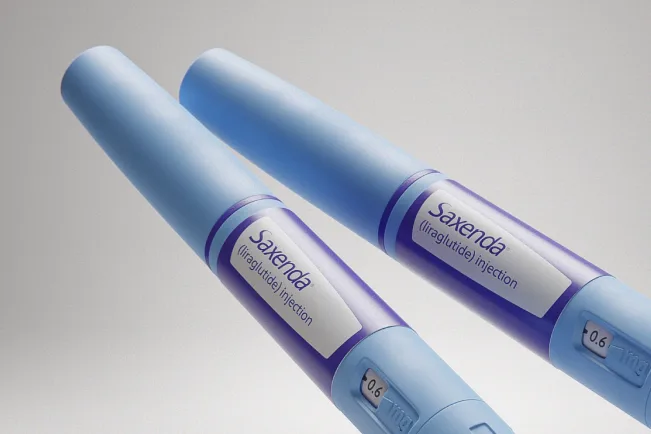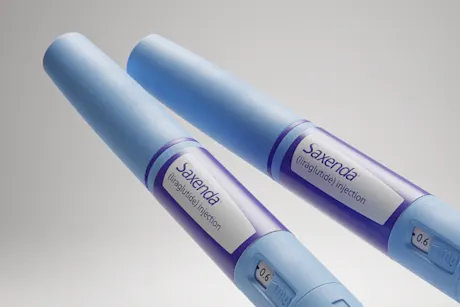

Important Safety Information for Saxenda
Warning: Risk of Thyroid C-Cell Tumors
In rats and mice, Saxenda caused thyroid tumors, including thyroid cancer. It is not known if Saxenda will cause thyroid tumors or a type of thyroid cancer called medullary thyroid carcinoma (MTC) in people. In the post marketing period, cases of MTC in people treated with liraglutide have been reported; the data in these reports are insufficient to establish or exclude a causal relationship between MTC and liraglutide use in people. Tell your provider if you get a lump or swelling in your neck, hoarseness, trouble swallowing, or shortness of breath. These may be symptoms of thyroid cancer.
Do not use Saxenda if you or any of your family have ever had a type of thyroid cancer called medullary thyroid carcinoma (MTC) or if you have an endocrine system condition called Multiple Endocrine Neoplasia syndrome type 2 (MEN 2).
What is the FDA-approved use of Saxenda?
Saxenda is a glucagon-like peptide-1 (GLP-1) receptor agonist for chronic weight management, along with a reduced calorie diet and increased physical activity, for people with an initial body mass index (BMI) of:
30 kg/m2 or greater (obesity) or
27 kg/m2 or greater (overweight) in the presence of at least one weight-related comorbid condition (e.g., hypertension, type 2 diabetes mellitus, or dyslipidemia).
Limitations of Use:
Saxenda should not be used in combination with other liraglutide-containing products or any other GLP-1 receptor agonist
The safety and efficacy of coadministration with other products for weight loss have not been established
Who should not use Saxenda?
Do not use Saxenda if:
You or any of your family have ever had a type of thyroid cancer called medullary thyroid carcinoma (MTC) or if you have an endocrine system condition called Multiple Endocrine Neoplasia syndrome type 2 (MEN 2).
You are pregnant
You have a known allergic reaction to Saxenda or any other GLP-1 receptor agonist
How should Saxenda be administered?
You can take Saxenda with or without food. The pre-filled injector pen is self-administered as a subcutaneous injection in the stomach, thigh, or upper arm once a day at any time of day. If injecting within the same region, the injection site should be rotated to reduce the risk of cutaneous amyloidosis. You should not change your dosing regimen or stop taking Saxenda as prescribed without discussing with your provider first.
What should I tell my provider before using Saxenda?
Saxenda has certain drug interactions. It’s important to tell your provider all of the medications you are currently taking, including prescription, over-the-counter medications, vitamins, and herbal and dietary supplements. Some medications to watch out for include:
Medications for diabetes: Medications used to treat type 1 or type 2 diabetes, including insulin or sulfonylureas (such as Amaryl or Glucotrol XL)
Other oral medications: Saxenda causes a delay in gastric emptying, so it can impact the absorption of medications that are taken by mouth at the same time. Your provider can guide you on how to schedule your medications.
Other GLP-1 medications: Including Wegovy, Ozempic, Mounjaro, Trulicity, Victoza, Byetta, or Bydureon. These medications should not be taken with Saxenda.
Other products for weight loss: Including dietary supplements
It’s important to share your entire medical history with your provider. In particular, tell your provider if you have or have a past history of:
Thyroid cancer
Type 1 or type 2 diabetes
Pancreatitis or gastrointestinal disease
Kidney disease
Depression
Suicide attempts or active suicidal ideation
Tell your provider if you are pregnant, planning to become pregnant, or breastfeeding.
If you are pregnant: Saxenda should not be used during pregnancy. There is no benefit to weight loss during pregnancy. Based on animal studies, there may be potential risks to an unborn baby from exposure to Saxenda during pregnancy.
If you are breastfeeding: It is not known if Saxenda passes into breast milk. Saxenda was found in the milk of lactating rats. Talk to your provider first about the benefits and risks of using Saxenda while breastfeeding.
Withholding or providing inaccurate information about your health and medical history in order to obtain treatment may result in harm, including, in some cases, death.
What are the most serious side effects that I or a caregiver should monitor for when taking Saxenda?
If you are experiencing a medical emergency, call 911 or seek immediate medical attention.
These serious side effects can occur with Saxenda. You or a caregiver should carefully monitor for these side effects, especially in the beginning of treatment and with dose changes.
Thyroid C-Cell Tumors: In rats and mice, Saxenda caused dose-dependent and treatment-duration-dependent thyroid C-cell tumors. It is unknown whether Saxenda causes thyroid C-cell tumors, including medullary thyroid cancer (MTC), in humans. Cases of MTC in people treated with liraglutide have been reported in the postmarketing period; the data in these reports are insufficient to establish or exclude a causal relationship between MTC and liraglutide use in people. Saxenda is contraindicated in patients with a family history of MTC or in patients with Multiple Endocrine Neoplasia syndrome type 2 (MEN 2). Tell your provider if you get a lump or swelling in your neck, hoarseness, trouble swallowing, or shortness of breath. These may be symptoms of thyroid cancer.
Inflammation of Pancreas (Acute Pancreatitis): Monitor for signs of acute pancreatitis, including severe abdominal pain that does not go away, sometimes radiating to the back, with or without vomiting.
Acute Gallbladder Disease: Some patients reported gallbladder problems in clinical trials, including gallstones. Some gallbladder problems require surgery. Tell your provider right away if you have pain in your upper stomach, yellowing of skin or eyes (jaundice), fever, or clay-colored stools.
Low Blood Sugar (Hypoglycemia): Saxenda lowers blood glucose. It can cause too low blood sugar in patients with type 2 diabetes who also take another glucose control medication. Monitor your blood sugar and watch out for signs of too low blood sugar such as dizziness, blurred vision, mood changes, sweating, or fast heartbeat.
Increase in Heart Rate: Tell your provider right away if you have a fast, racing heartbeat while at rest.
Acute Kidney Injury: In patients treated with GLP-1 receptor agonists like Saxenda, there have been reports of acute renal failure and worsening of chronic kidney failure, sometimes requiring hemodialysis. Gastrointestinal side effects of Saxenda like diarrhea, nausea, and vomiting may cause a loss of fluids (dehydration), which may cause kidney problems if dehydration is severe. It is important to drink plenty of water to help reduce your chance of dehydration.
Allergic Reactions: Stop using Saxenda right away if you experience symptoms of a serious allergic reaction, including swelling of your face, lips, tongue or throat, severe rash or itching, very rapid heartbeat, problems breathing or swallowing, or fainting or feeling dizzy.
Suicidal Behavior and Ideation: You should pay attention to any mental health changes, especially sudden changes in your mood, behaviors, thoughts, or feelings. Call your healthcare provider right away if you have any mental changes that are new, worse, or worry you.
Never Share a Pen: Pen-sharing poses a risk of infection.
What are the most common side effects of Saxenda?
Nausea
Diarrhea
Constipation
Vomiting
Injection site reactions
Headache
Low blood sugar
Stomach discomfort
Fatigue
Dizziness
Stomach pain
Increased in lipase
Upper abdominal pain
Fever
Stomach infection
You are encouraged to report negative side effects of prescription products:
Contact Novo Nordisk Inc. at 1-844-363-4448
Contact FDA MedWatch at 1-800-FDA-1088 or visit www.fda.gov/medwatch
This information is not comprehensive. Please see the full Prescribing Information for complete safety information.